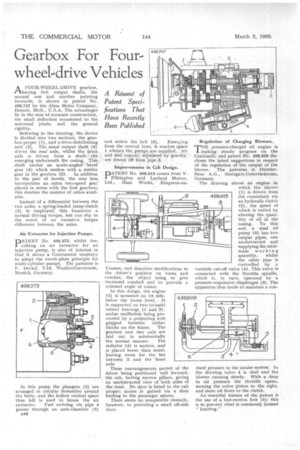Gearbox For Four wheel-drive Vehicles
Page 56

If you've noticed an error in this article please click here to report it so we can fix it.
A FOUR-WHEEL-DRIVE gearbox, 1-1.having fwb output shafts, the normal one and another pointing forwards, is shown in patent No. 498,747 by the. Alma Motor Company, Detroit, Mich., U.S.A. The advantages lie in the ease of accurate construction, the small deflection occasioned to the universal joints, and the general rigidity.
Referring to the drawing. thedevice • is divided into two sections, the gearbox proper (1), and a drive-distributing unit (2). The usual output shaft (3) drives the rear axle, whilst the front axle is driven from a shaft (6) emerging underneath the casing. This shaft carries an acute-angled bevel gear (4) which meshes with a similar gear in the gearbox (2). In addition to the pair of bevels, the rear box incorporates an extra two-speed gear placed in series with the first gearbox; this doubles the number of ratios available.
Instead of a differential between the two axles, a spring-loaded jump-clutch. (5) is employed; this transmits a normal driving torque, but can slip in the event of an excessive torque difference between the axles.
Air Extractor for Injection Pumps.
PATENT No. 498,573, whilst describing an air extractor for an injection pump, is also of interest in that it shows a Continental tendency to adopt the swash-plate principle for multi-cylinder pumps. The patentee is F. nickel, 7-13, Waalcirchnerstrasse, Munich, Germany.
In this pump the plungers (2) are arranged in circular formation around the body, and the hollow central space thus left is used to house the air extractor. Fuel arriving via pipe 4 passes through an ante-chamber (3) a46 and enters the bell (6). Emerting from the central bore, it reaches space I whence the pumps are supplied. Air and fuel vapour, Aeparated by gravity, are drawn off from pipe 3.
Improvements in Cali Design.
PATENT No. 498,613 comes from V. Pilkington and Leyland Motors. Ltd.; Ham Works, Kingston-on
Thames, and describes modifications to the driver's position on buses and coaches, the object being to give increased comfort and to provide a widened angle of vision.
In this design, the engine (2) is mounted on its side, below the frame level. . It is supported on two co-axial rubber bearings (1 and ,3). undue oscillation being prevented by a projecting arm gripped between rubber blocks on the frame. The gearbox and rear axle are laid out in substantially
the normal manner. The radiator (4) is narrow, and is placed lower than usual. leaving room for the fan between it and the front axle
These rearrangements permit of the driver being positioned well forward, the cab, having narrow pillars, giving an unobstructed view of both sides of the road. No door is fitted to the cab proper; access is gained via a door leading to the passenger saloon.
There seems no insuperable obstacle, however, to providing a small off-side door. Regulation of Charging Blowers.
T" pressure-charged oil engine is making steady progress on the Continent, and patent No 498,808 disclose,'s the latest suggestions in respect of the regulation of the output of the blower. The patentee is DaimlerBenz A.G., Stuttgart-Unterturkheim, Germany.
The drawing shows an engine in which the. blower (1) is driven from the crankshaft via an hydraulic clutch (2), the speed of which is varied by altering the quantity of oil. in the casing. To this ,end, a dual oilpump (3) has two output pipes, one unobstructed and supplying the minimum working quantity, whilst the other pipe is controlled by a variable cut-off valve (4), This valve is connected with the throttle spindle, which is, in tirrn, operated by a pressure-responsive diaphragm. (6). The apparatus thus tends to maintain a con.
stant pressure in the intake system. In the drawing valve 4 is shut and the blower running slowly. With a drop in air pressure the throttle opens, moving the valve piston to the right, and more oil flows to the clutch.
An 'essential feature of the patent is the use of a lost-motion link (5); this is to prevent what is commonly termed " hunting."




















































































